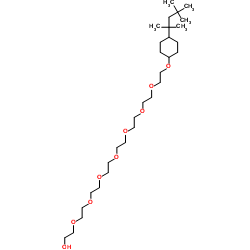Triton X-405, reduced

Triton X-405, reduced structure
|
Common Name | Triton X-405, reduced | ||
|---|---|---|---|---|
| CAS Number | 92046-34-9 | Molecular Weight | 564.792 | |
| Density | 1.0±0.1 g/cm3 | Boiling Point | 599.6±45.0 °C at 760 mmHg | |
| Molecular Formula | C30H60O9 | Melting Point | 48-50ºC(lit.) | |
| MSDS | Chinese USA | Flash Point | 316.5±28.7 °C | |
| Symbol |


GHS07, GHS09 |
Signal Word | Warning | |
|
An improved procedure for enzymatic digestion of polyvinylidene difluoride-bound proteins for internal sequence analysis.
Anal. Biochem. 218 , 112, (1994) An improved and simplified procedure for enzymatic digestion of proteins bound to polyvinylidene difluoride (PVDF) membranes for obtaining internal protein sequence data is presented. This improved procedure is compatible with various enzymes (trypsin, endopr... |
|
|
Effects of detergent environments on the photocycle of purified monomeric bacteriorhodopsin.
Biochemistry 30 , 1751, (1991) Time-resolved difference spectra have been obtained for the photocycle of delipidated bacteriorhodopsin monomers (d-BR) in six different detergent micelle environments that were prepared by two new detergent-exchange techniques. A global kinetic analysis of t... |
|
|
Internal protein sequence analysis: enzymatic digestion for less than 10 micrograms of protein bound to polyvinylidene difluoride or nitrocellulose membranes.
Anal. Biochem. 201 , 255, (1992) A procedure for the generation and isolation of internal peptide fragments for less than 10 micrograms of protein bound to either polyvinylidene difluoride (PVDF) or nitrocellulose membranes after electrophoretic transfer from sodium dodecyl sulfate-polyacryl... |
|
|
Hydrogenation of triton X-100 eliminates its fluorescence and ultraviolet light absorption while preserving its detergent properties.
Anal. Biochem. 141 , 262, (1984) The ultraviolet-light absorption and fluorescence of Triton X-100 were virtually eliminated by hydrogenation to its reduced cyclohexyl analog, RTX-100. The critical micelle concentration of RTX-100 was 12% higher than that of Triton X-100. RTX-100 and Triton ... |
|
|
The isolation of detergent-resistant lipid rafts for two-dimensional electrophoresis.
Methods Mol. Biol. 424 , 413-422, (2008) Because lipid rafts are plasma membrane platforms mediating various cellular events such as in signal transduction, immunological response, pathogen invasion, and neurodegenerative diseases, protein identification in the rafts could provide important informat... |
|
|
Nondetergent isolation of rafts.
Methods Mol. Biol. 398 , 21-28, (2007) Raft and caveolar microdomains have been proposed to participate in numerous cellular functions including signal transduction, cholesterol trafficking, and vesicular sorting. Traditional methods of isolation of rafts from cultured cells and tissue samples hav... |
|
|
Detergents as tools for the purification and classification of lipid rafts.
FEBS Lett. 559 , 1-5, (2004) The relative insolubility of lipid rafts in cold non-ionic detergents is the most widely used method to purify these fascinating membrane domains from intact cells or membranes. Most of what we know about lipid raft function has been derived from experiments ... |
|
|
Differential regulation of proliferation and neuronal differentiation in adult rat spinal cord neural stem/progenitors by ERK1/2, Akt, and PLCγ.
Front. Mol. Neurosci. 6 , 23, (2013) Proliferation of endogenous neural stem/progenitor cells (NSPCs) has been identified in both normal and injured adult mammalian spinal cord. Yet the signaling mechanisms underlying the regulation of adult spinal cord NSPCs proliferation and commitment toward ... |
|
|
Mammalian long-chain acyl-CoA synthetases. Soupene E, Kuypers FA.
Exp. Biol. Med. 233 , 507-521, (2008)
|